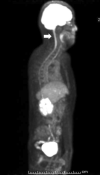Asymptomatic meningitis diagnosed by positron emission tomography in a patient with syndrome of inappropriate antidiuretic hormone secretion: a case report
- PMID: 34289912
- PMCID: PMC8296630
- DOI: 10.1186/s13256-021-02956-6
Asymptomatic meningitis diagnosed by positron emission tomography in a patient with syndrome of inappropriate antidiuretic hormone secretion: a case report
Abstract
Background: Syndrome of inappropriate antidiuretic hormone secretion can be caused by arginine-vasopressin-producing tumors or enhanced arginine vasopressin secretion from the posterior pituitary gland due to central nervous system disorders and intrathoracic diseases.
Case presentation: A 53-year-old Asian man was hospitalized with complaints of tremor and hiccups. Laboratory examination revealed findings suggestive of hypotonic hyponatremia due to syndrome of inappropriate antidiuretic hormone secretion. The patient did not complain of headache or photophobia, and showed no signs of meningeal irritation. Positron emission tomography-computed tomography revealed 18F-fluoro-deoxy-glucose accumulation along the cervical spinal cord, based on which the patient was diagnosed as having aseptic meningitis. The hyponatremia was treated successfully by fluid restriction, and optimum plasma sodium concentration was maintained by tolvaptan administration.
Conclusions: This case underscores the need to consider the possibility of mild meningitis as the cause of syndrome of inappropriate antidiuretic hormone secretion in patients without other identifiable cause.
Keywords: Aseptic meningitis; Hyponatremia; SIADH; Vasopressin.
© 2021. The Author(s).
Conflict of interest statement
The authors declare that they have no competing interests.
Figures


Similar articles
-
Rapidity of Correction of Hyponatremia Due to Syndrome of Inappropriate Secretion of Antidiuretic Hormone Following Tolvaptan.Am J Kidney Dis. 2018 Jun;71(6):772-782. doi: 10.1053/j.ajkd.2017.12.002. Epub 2018 Feb 23. Am J Kidney Dis. 2018. PMID: 29478867 Free PMC article.
-
Effect of tolvaptan on hyponatremia in a dog with syndrome of inappropriate secretion of antidiuretic hormone.J Vet Med Sci. 2023 Oct 17;85(10):1047-1051. doi: 10.1292/jvms.23-0243. Epub 2023 Aug 16. J Vet Med Sci. 2023. PMID: 37587049 Free PMC article.
-
Prompt efficacy of tolvaptan in treating hyponatremia of syndrome of inappropriate secretion of antidiuretic hormone (SIADH) closely associated with rupture of a gastric artery aneurysm.Intern Med. 2014;53(8):845-9. doi: 10.2169/internalmedicine.53.1440. Epub 2014 Apr 15. Intern Med. 2014. PMID: 24739604
-
Tolvaptan Treatment in Children with Chronic Hyponatremia due to Inappropriate Antidiuretic Hormone Secretion: A Report of Three Cases.J Clin Res Pediatr Endocrinol. 2017 Sep 1;9(3):288-292. doi: 10.4274/jcrpe.4531. Epub 2017 May 17. J Clin Res Pediatr Endocrinol. 2017. PMID: 28515029 Free PMC article. Review.
-
Syndrome of inappropriate secretion of antidiuretic hormone (SIADH) associated with lateral medullary syndrome: case report and literature review.BMC Neurol. 2016 Jul 27;16:119. doi: 10.1186/s12883-016-0641-0. BMC Neurol. 2016. PMID: 27461339 Free PMC article. Review.
Cited by
-
Pathogenesis and treatment of perioperative hiccups: a narrative review.Ann Med. 2025 Dec;57(1):2474173. doi: 10.1080/07853890.2025.2474173. Epub 2025 Mar 8. Ann Med. 2025. PMID: 40055925 Free PMC article.
References
Publication types
MeSH terms
Substances
LinkOut - more resources
Full Text Sources
Medical

